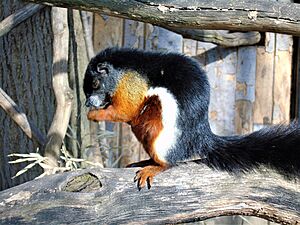Squirrel facts for kids
Quick facts for kids Squirrels |
||||||||||
|---|---|---|---|---|---|---|---|---|---|---|
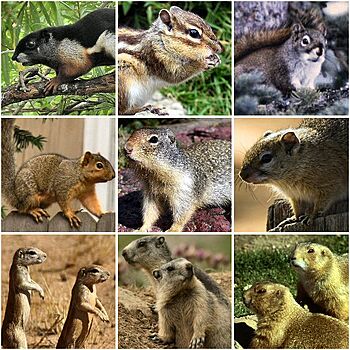 |
||||||||||
Various members of the family Sciuridae
|
||||||||||
| Scientific classification |
||||||||||
| Kingdom: | Animalia | |||||||||
| Phylum: | Chordata | |||||||||
| Class: | Mammalia | |||||||||
| Order: | Rodentia | |||||||||
| Suborder: | Sciuromorpha | |||||||||
| Family: | Sciuridae Fischer de Waldheim, 1817 |
|||||||||
| Type genus | ||||||||||
| Sciurus Linnaeus, 1758
|
||||||||||
| Subfamilies and tribes | ||||||||||
|
||||||||||
Squirrels are a fascinating group of small or medium-sized rodents. They belong to a special animal family called Sciuridae. This family includes many different kinds of squirrels. You might know tree squirrels, but there are also ground squirrels. Ground squirrels include cute chipmunks and playful prairie dogs. And don't forget the amazing flying squirrels!
Squirrels live all over the world. You can find them in the Americas, Europe, Asia, and Africa. Humans even brought them to Australia. The very first squirrel fossils we know about are from a time called the Eocene epoch. This was a very long time ago! Among other living rodents, squirrels are most closely related to the mountain beaver and dormice.
Contents
Amazing Squirrels: Nature's Acrobats
Where Did the Name "Squirrel" Come From?
The word squirrel first appeared in English around the year 1327. It comes from an old French word, which itself came from a Latin word. That Latin word, sciurus, was borrowed from an Ancient Greek word. In Greek, skiouros means "shade tail." This name perfectly describes many squirrels. It refers to their long, bushy tails that can look like a shade or umbrella. The scientific name for one group of squirrels is also Sciurus.
What Do Squirrels Look Like?
Squirrels are usually small animals. Their size can vary a lot. Some, like the African pygmy squirrel, are tiny. They are only about 10-14 centimeters long and weigh just 12-26 grams. Others, like the Bhutan giant flying squirrel, can be much bigger. They can be up to 1.27 meters long. Some marmots, which are a type of ground squirrel, can weigh 8 kilograms or more!
Most squirrels have slender bodies. They have long, bushy tails and big, bright eyes. Their fur is usually soft and silky. However, some species have much thicker fur. Squirrels come in many different colors. Their coat color can even change within the same species.
Squirrels have special feet for climbing. Their back legs are often longer than their front legs. They have four or five toes on each foot. Their feet have soft pads and strong claws. These claws help them grip surfaces and climb easily. Tree squirrels are amazing climbers. They can even climb down a tree headfirst! They do this by rotating their ankles 180 degrees. This lets their hind feet point backward and grip the tree bark.
Their Super Senses
Squirrels have excellent vision. Their large eyes help them see very well, especially those that live in trees. Many squirrels also have a great sense of touch. They have vibrissae on their faces and even on their limbs. These whiskers help them feel their surroundings.
Their teeth are perfect for gnawing. Like all rodents, squirrels have large incisors at the front. These teeth grow continuously throughout their lives. They also have cheek teeth at the back for grinding food. There's a wide gap between their front and back teeth, called a diastema.
Their Special Tail
A squirrel's tail is more than just pretty! It helps them in many ways:
- It keeps them warm and dry in bad weather.
- It helps them cool down when they are hot. They can pump more blood through their tail.
- It acts like a balance pole when they jump between branches.
- It can even work like a parachute if they fall from a height.
- Squirrels use their tails to send signals to other squirrels.
The fine hairs from squirrel tails are also used by people. They are popular for tying fishing flies for fly fishing. When a squirrel sits upright, its tail can also help it hide. It can make the squirrel's shape less obvious to predators.
The Life Cycle of a Squirrel
Squirrels live in almost every type of environment. You can find them in tropical rainforests and dry deserts. They avoid only the very cold polar areas and the driest deserts. Most squirrels are herbivorous, meaning they eat plants. They love seeds and nuts. However, many squirrels also eat insects and even small animals.
Many young squirrels do not survive their first year. Adult squirrels can live for 5 to 10 years in the wild. Some squirrels in zoos or as pets can live even longer, up to 10 to 20 years. Sometimes, a nest might fall from a tree. If the baby squirrels get too cold, their mother might leave them. Luckily, many baby squirrels have been saved and cared for by wildlife rehabilitators. These experts help them grow strong enough to return to the wild.
How Squirrels Behave
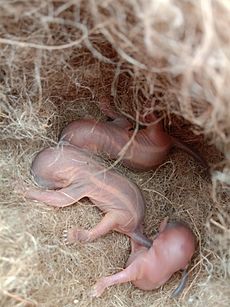
Squirrels usually mate once or twice a year. After a gestation period of three to six weeks, they give birth to their young. The number of babies depends on the squirrel species. Baby squirrels, called kits, are born helpless. They are naked, without teeth, and blind. In most species, only the mother cares for the young. They are weaned (stop drinking milk) at six to ten weeks. They become adults by the end of their first year.
Ground squirrels often live in groups, forming colonies. Tree squirrels, however, usually prefer to live alone. Most ground and tree squirrels are active during the day (diurnal) or at dawn and dusk (crepuscular). Flying squirrels are usually active at night (nocturnal). However, mothers with young might be active during the day in summer.
When it's very hot, squirrels sometimes lie flat on cool surfaces. This behavior is called "splooting." It helps them cool down their bodies.
Food and Feeding Habits
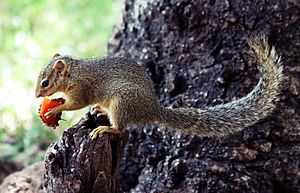
Squirrels cannot digest cellulose, which is a tough part of plants. So, they need foods rich in protein, carbohydrates, and fats. Early spring can be a tough time for squirrels in cooler places. The nuts they buried might start to sprout. This means they can't eat them anymore. Also, many other food sources are not ready yet. During these times, squirrels often eat tree buds.
While squirrels are mostly herbivores, they eat many different plants. They enjoy nuts, seeds, conifer cones, fruits, fungi, and green vegetation. Some squirrels will also eat meat, especially if they are very hungry. They have been seen eating small birds, young snakes, and even other small rodents. They also eat bird eggs and insects. Some tropical squirrels mostly eat insects.
Squirrels are very good at living near humans. This is called being "synanthropic." They learn to live and even thrive in cities and towns. For example, squirrels were brought back to New York City after many disappeared. They were reintroduced to help people feel connected to nature. They adapted so well that sometimes they can become bold if they can't find food easily.
Some ground squirrels, like the thirteen-lined ground squirrel, can be aggressive. They have been seen eating small animals like young chickens or freshly killed snakes. Another type, the white-tailed antelope squirrel, also eats small vertebrates like lizards and rodents. It's very rare for squirrels to attack humans.
Smart Food Storage
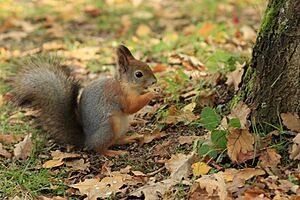
Squirrels have clever ways to store food. This helps them during times when food is scarce. In cooler areas, squirrels often bury nuts under leaves or in hollow trees. They also bury them underground. But in warm, humid places, buried food can get moldy or sprout too soon.
To solve this, some squirrels in warm areas hang nuts or mushrooms on tree branches. This helps prevent mold and keeps the food safe. This behavior also helps certain trees, like Cyclobalanopsis. If a squirrel forgets a nut, it might sprout in a new place. This helps the forest grow! Two types of flying squirrels, the particolored flying squirrel and Hainan flying squirrel, even carve grooves into nuts. This helps them wedge the nuts tightly into tree twigs.
Types of Squirrels
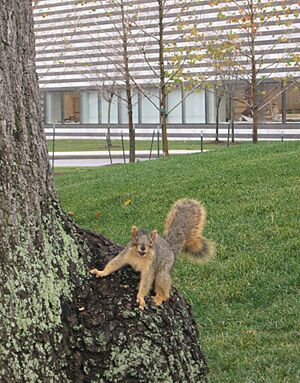
There are many different kinds of squirrels in the world. Scientists divide living squirrels into five main groups, called subfamilies. There are about 58 different groups of squirrels, called genera, and around 285 different species!
The oldest squirrel fossil, named Hesperopetes, is about 40–35 million years ago old. It looked similar to modern flying squirrels. Scientists believe that squirrels as a group might have first appeared in North America. This is because the oldest types of squirrels seem to have spread out from there.
The main groups of squirrels include:
- The Ratufinae, also known as Oriental giant squirrels. These are large squirrels found in tropical Asia.
- The Sciurillinae, which includes only one species, the neotropical pygmy squirrel from South America.
- The Sciurinae, which has the amazing flying squirrels and the familiar tree squirrels. These are found all over the world.
- The Callosciurinae, which are often called Asian ornate squirrels. They are mostly found in Southeast Asia.
- The Xerinae, which includes many types of ground squirrels. This group has marmots, chipmunks, and prairie dogs. They are found in many parts of the world.
Images for kids
-
Squirrel in Chandigarh
-
Squirrel on mango tree
See also
 In Spanish: Esciúridos para niños
In Spanish: Esciúridos para niños




